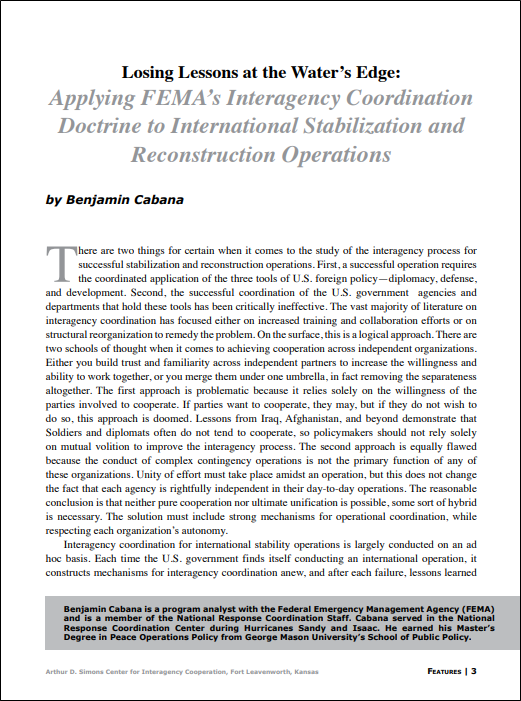Featured Article: Losing Lessons at the Water’s Edge
Featured article:
Losing Lessons at the Water’s Edge: Applying FEMA’s Interagency Coordination Doctrine
to International Stabilization and Reconstruction Operations
by Benjamin Cabana
There are two things for certain when it comes to the study of the interagency process for successful stabilization and reconstruction operations. First, a successful operation requires the coordinated application of the three tools of U.S. foreign policy—diplomacy, defense, and development. Second, the successful coordination of the U.S. government agencies and departments that hold these tools has been critically ineffective. The vast majority of literature on interagency coordination has focused either on increased training and collaboration efforts or on structural reorganization to remedy the problem. On the surface, this is a logical approach. There are two schools of thought when it comes to achieving cooperation across independent organizations. Either you build trust and familiarity across independent partners to increase the willingness and ability to work together, or you merge them under one umbrella, in fact removing the separateness altogether. The first approach is problematic because it relies solely on the willingness of the parties involved to cooperate. If parties want to cooperate, they may, but if they do not wish to do so, this approach is doomed. Lessons from Iraq, Afghanistan, and beyond demonstrate that Soldiers and diplomats often do not tend to cooperate, so policymakers should not rely solely on mutual volition to improve the interagency process. The second approach is equally flawed because the conduct of complex contingency operations is not the primary function of any of these organizations. Unity of effort must take place amidst an operation, but this does not change the fact that each agency is rightfully independent in their day-to-day operations. The reasonable conclusion is that neither pure cooperation nor ultimate unification is possible, some sort of hybrid is necessary. The solution must include strong mechanisms for operational coordination, while respecting each organization’s autonomy.
Interagency coordination for international stability operations is largely conducted on an ad hoc basis. Each time the U.S. government finds itself conducting an international operation, it constructs mechanisms for interagency coordination anew, and after each failure, lessons learned…
Read the full article
Download the complete edition
IAJ 5-2 (2014) pdf
Benjamin Cabana is a program analyst with the Federal Emergency Management Agency (FEMA) and is a member of the National Response Coordination Staff. Cabana served in the National Response Coordination Center during Hurricanes Sandy and Isaac. He earned his Master’s Degree in Peace Operations Policy from George Mason University’s School of Public Policy.

READ THE LATEST UPDATES FROM THE SIMONS CENTER
"*" indicates required fields


